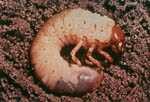The insects have a three year life-cycle. The adults are nocturnal. They remain in the soil during the day and fly to nearby trees on warm evenings where they feed on the foliage. Eggs are laid in the soil, usually in grassy areas and the larvae hatch within 30 days. The first instar larvae are commonly found in July. They feed on decaying vegetation, fungi and plant rootlets. They usually feed at a depth of 5 cm or less in sod, deeper on other plants and they move from plant to plant as they consume the roots. They molt in mid-August and the second instar grubs feed until late fall when they move downward in the soil to overwinter. The second year of the cycle is known as the 'White Grub Year'. During that time, the second instar larvae feed and molt into the third or final instar around the third week of June. Grubs of this last instar are the most injurious, feeding at a depth of 5 to 25 cm, depending upon the soil and the type of food plants. Again, the larvae move downward in the soil to overwinter and, in the third growing season, those that were not full-grown continue to feed before pupating. Most of the grubs form cells in the soil 20 to 25 cm below the surface during July and pupate. Adults emerge the same year.
Crop Injury
The grubs may damage potato crops on land that has recently been in sod. If feeding on potato is severe, damage is indicated by dwarfing or wilting of the plants. The grubs chew deep cavities in the tubers, making them totally unmarketable.
Pest Management
Summer tillage is usually adequate because it exposes the larvae to predators.
Monitoring - Estimates of the density of the soil inhabiting stages are done by taking sample units of 0.09 square meters of soil to a depth of 30 cm. The soil samples are examined and larvae counted. An economic threshold is not available.
Cultural Practices - Planting of susceptible plants in recently ploughed grass sod should be avoided. Infested fields should be harrowed, which kills the grubs by physical injury or exposes them to natural enemies and the elements. Tillage should be timed between early May and late June to kill the second year grubs and from late July to early September for first year grubs.

